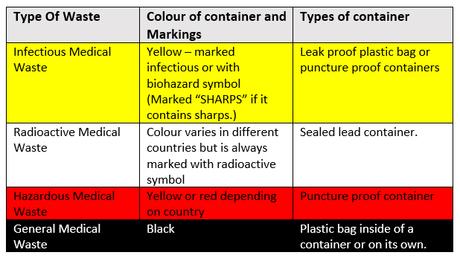Anybody who works in a health care environment such as a hospital, dentistry office, veterinary practice or any kind of laboratory, knows that the waste they produced is handled is a specific way. Waste types from these environments have strict disposal guidelines and laws for handling and categorisation.
What Are The Different Types Of Medical Waste?
Typically there are 4 main types of medical waste that are all handled slightly differently. These medical waste types are:
Below is a summarised table containing the storage container types and colour typical colour classification codes for these type of medical waste.

The four main categories often break off into smaller categories which also have their own color segregation systems for storage and disposal
Hazardous Waste Color Bags
Cytotoxic Waste
Cytotoxic waste typically will be segregated into purple puncture proof containers or yellow containers with a purple lid. Types of cytotoxic waste includes:
- Blister packs
- Unopened medicine vials
- Tablets in containers
- Patches
- Gloves, gowns or aprons that have been contaminated with cytotoxic medicines.
The best known method of disposing of cytotoxic waste is by incineration.
Anatomical Waste
Anatomical waste is a sub-type of pathological waste. The difference is that anatomical waste is recognisably human. Examples of anatomical waste would be:
Anatomical waste is generally stored in a sealed red waste container or leak proof red bags. And requires disposal by incineration.
Clinical Waste
Clinical waste falls into the infectious waste category which is segregated into yellow plastic bags or sealed containers. This waste type requires incineration for complete disposal. The bag or container will usually be labelled "INFECTIOUS". Examples of infectious clinical waste are:
- Wipes
- Dressings
- Gloves
- Aprons
- Bandages
- Disposable garments contaminated with body fluids
Radioactive Waste
For radioactive waste, there is no universal color as it varies depending on the location. However all radioactive waste containers are sealed, lead containers with the radioactive symbol on the front. Types of radioactive waste are:
- Radioactive agents such as iodine used to treat thyroid glands
- Any medical equipment used to give treatment that may have come into contact with certain isotopes
- Clothing worn when giving radiation treatment
- Radiation source
Chemical and Pharmaceutical Waste
Chemical and pharmaceutical waste is anything that contains drugs that needs to be disposed of. This can include things such as:
- Out of date medicine and prescriptions
- Discontinued, unused preparations
- Intravenous preparations
- Partially used vials, syringes and IV's
Pharmaceutical waste should be stored In a brown bag or brown rigid container. The recommended method of disposal or pharmaceuticals is by incineration to ensure complete combustion of any chemicals.
Non-hazardous waste color bags
Medicinal Waste
Medicinal waste types are considered non-hazardous waste that requires disposal by incineration. Examples of this waste are:
- Tablets in containers
- Unopened medicine vials
- Droplet bottles with pipettes
- Blister packs
- Inhaler cartridges
The color categorisation for this waste type is typically a blue container but, in some countries, it may be a yellow container with a blue lid.
Offensive Waste
Offensive waste can vary dramatically around the world. What is seen as offensive waste in one country, may be completely different in another. Some examples of what could considered offensive waste are:
- Nappies and wipes
- Incontinence pads
- Hospital gowns not contaminated with blood or body fluids
- Syringes un-used without the needle
- Colostomy bags
Offensive waste is safe to incinerate and should be disposed of in a yellow bag with black striped markings.
Why Should You Follow The Medical Waste Classification System?
Medical waste segregation is vital to ensure that all types of medical waste is sorted, transported, treated and disposed of correctly. The classification of waste at the point of generation makes sure that the waste is managed safely and does not pose a risk of infection or disease to anyone coming into contact with the waste bags.
By following the waste classification process, companies and organisations will find it easier to manage their waste management costs and keep their healthcare facility clean and free from contamination. It also allows medical waste disposal to be a quick and easy process. Click here for more information on medical waste and the classification system.
Inciner8 offer a large range of medical incinerators for various different types of medical waste.
See also:

